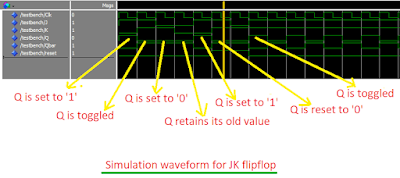The code is written using behavioral modelling. When the reset is low( '0' ) and the value of Clk changes from 0 to 1, we check the value of J and K through if else statements and set the value of Q and Qbar accordingly.
The reset input in this JK flipflop is said to be asynchronous because its value is checked independent of the state of the clock signal.
The code was synthesized using Xilinx ISE. The RTL schematic of the design is shown below:
VHDL Code for JK Flipflop:
--libraries to be used are specified here library ieee; use ieee.std_logic_1164.all; --entity declaration with port definitions entity JK_flipflop is port(Clk : in std_logic; --positive edge triggered J, K: in std_logic; reset: in std_logic; --active high reset Q, Qbar: out std_logic ); end JK_flipflop; --architecture of entity architecture Behavioral of JK_flipflop is --temporary signals. --they are used because, output ports cannot be read in the VHDL versions prior to 2008. signal qtemp, qbartemp : std_logic := '0'; begin --assign the temporary signals to corresponding output ports. --'Qbar' is always 'not' of 'Q'. Q <= qtemp; Qbar <= qbartemp; --process for JK flip flop process(Clk,reset) begin if(reset = '1') then --Reset the output when reset is high qtemp <= '0'; qbartemp <= '1'; elsif(rising_edge(clk)) then if(J='0' and K='0') then --No change in the output NULL; elsif(J='0' and K='1') then --Set the output Q. qtemp <= '0'; qbartemp <= '1'; elsif(J='1' and K='0') then --Reset the output Q. qtemp <= '1'; qbartemp <= '0'; else --Toggle the output Q. qtemp <= not qtemp; qbartemp <= not qbartemp; end if; end if; end process; end Behavioral;
Testbench code for JK Flipflop:
--library declarations library ieee; use ieee.std_logic_1164.all; --this is how entity for your test bench code has to be declared. entity testbench is end testbench; architecture behavior of testbench is --Signal declarations signal Clk,J,K,reset,Q,Qbar : std_logic := '0'; -- Clock period definitions constant Clk_period : time := 10 ns; begin -- Instantiate the Unit Under Test (UUT). --This style is known as entity instantiation with named association UUT : entity work.JK_flipflop port map(Clk => Clk, J => J, K => K, reset => reset, Q => Q, Qbar => Qbar); --Generate Clk with a period of 'Clk_period' Clk_generation: process begin Clk <= not Clk; --toggle 'Clk' when half 'Clk_period' is over. wait for Clk_period/2; end process; -- Stimulus process stimulus: process begin --change J and K and wait for a Clock period to see the changes J<='1'; K<='0'; wait for Clk_period; J<='1'; K<='1'; wait for Clk_period; J<='0'; K<='1'; wait for Clk_period; J<='0'; K<='0'; wait for Clk_period; J<='1'; K<='0'; wait for Clk_period; --apply reset input and change J and K. reset <='1'; J<='1'; K<='1'; wait for Clk_period; J<='0'; K<='1'; wait for Clk_period; --reset is made 'low' again. reset <='0'; --now onwards, Q will keep toggling between 1 and 0. J<='1'; K<='1'; wait for Clk_period; wait; end process; end;
Simulation Waveform:
The codes were simulated in Modelsim. This is a screenshot of the waveform.
In the schematic FDPE represents a single D-type flip-flop with data (D), clock enable (CE), and asynchronous preset (PRE) inputs and data output (Q). Similarly FDCE represents a single D-type flip-flop with data (D), clock enable (CE), and asynchronous clear (CLR) inputs and data output (Q).


Q <= qtemp;
ReplyDeleteQbar <= qbartemp; you placed it above the process statement, is any thing wrong if i placed it after end if statements?
can u explain the simulation of the above architecture body.(what i want to know is like compilation steps in 'C')
@ashok : If you put them inside the process statement then, it gets executed only on clock edges. Also you may get a synthesis error.
ReplyDeleteIt is better to place those statements outside the process.Because we are assigning the temporary variable values to output signals, and we want to update the values immediately.
Why doesn't XST infer a single DFF with preset and clear?
ReplyDeleteWhy did you use qtemp and qbartemp? Can I use Q and Qbar directly in the process? Thanks ^^
ReplyDeleteI asked the same question
DeleteIn vhdl, you cannot operate on the outputs. For example , this statement wouldnt be allowed:
Deleteq <= not q;
qbar <= not qbar;
i think Q and Qbar should be inout_std_logic in entity.......
ReplyDeletewe need conclusion for the above code
ReplyDelete